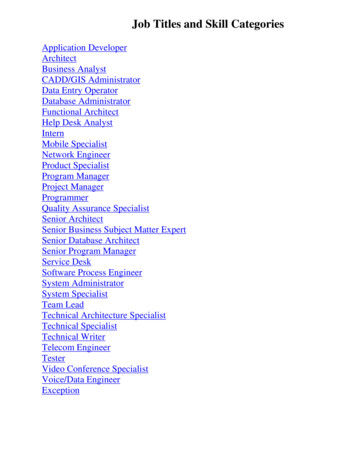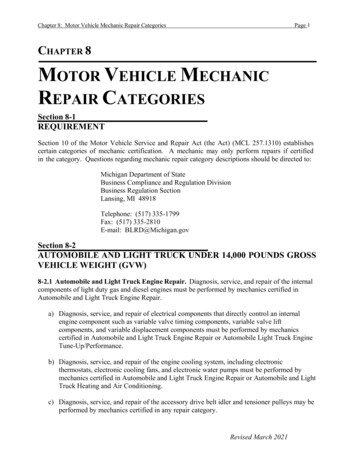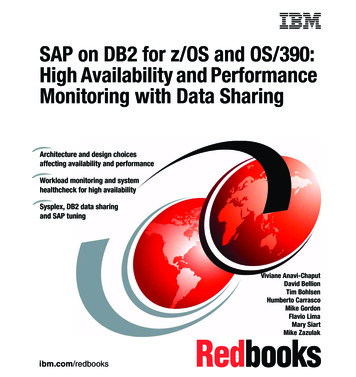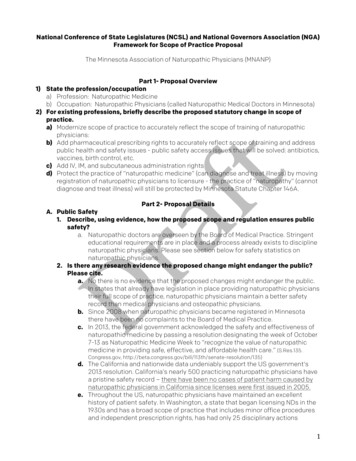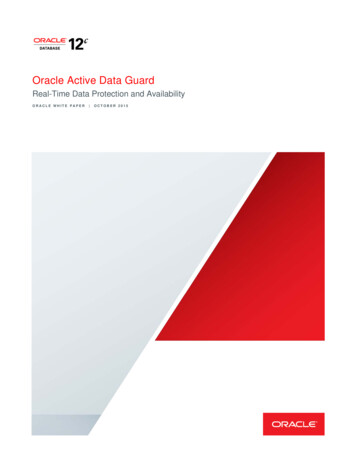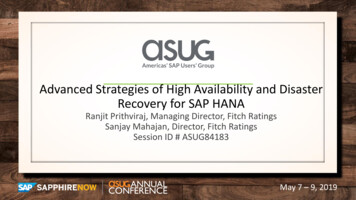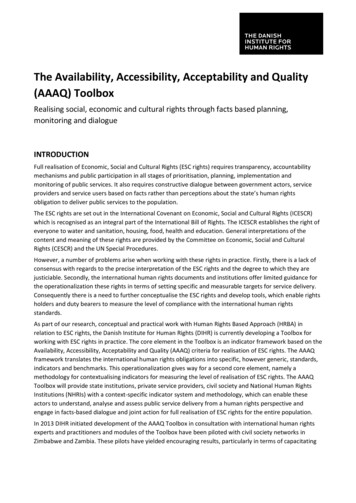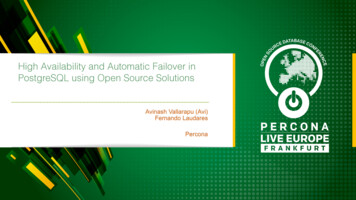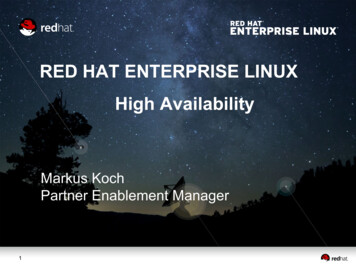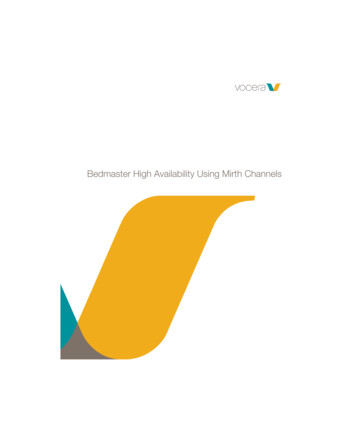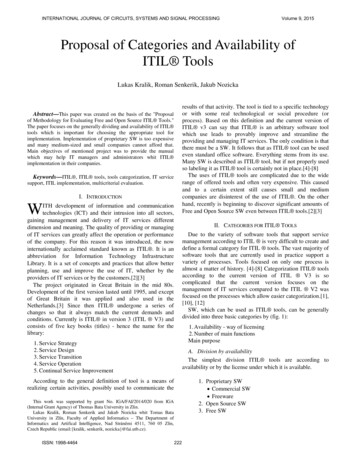
Transcription
INTERNATIONAL JOURNAL OF CIRCUITS, SYSTEMS AND SIGNAL PROCESSINGVolume 9, 2015Proposal of Categories and Availability ofITIL ToolsLukas Kralik, Roman Senkerik, Jakub Nozickaresults of that activity. The tool is tied to a specific technologyor with some real technological or social procedure (orprocess). Based on this definition and the current version ofITIL v3 can say that ITIL is an arbitrary software toolwhich use leads to provably improve and streamline theproviding and managing IT services. The only condition is thatthere must be a SW. It follows that as ITIL tool can be usedeven standard office software. Everything stems from its use.Many SW is described as ITIL tool, but if not properly usedso labeling it as ITIL tool is certainly not in place.[4]-[8]The uses of ITIL tools are complicated due to the widerange of offered tools and often very expensive. This causedand to a certain extent still causes small and mediumcompanies are disinterest of the use of ITIL . On the otherhand, recently is beginning to discover significant amounts ofFree and Open Source SW even between ITIL tools.[2][3]Abstract—This paper was created on the basis of the "Proposalof Methodology for Evaluating Free and Open Source ITIL Tools."The paper focuses on the generally dividing and availability of ITIL tools which is important for choosing the appropriate tool forimplementation. Implementation of proprietary SW is too expensiveand many medium-sized and small companies cannot afford that.Main objectives of mentioned project was to provide the manualwhich may help IT managers and administrators whit ITIL implementation in their companies.Keywords—ITIL , ITIL tools, tools categorization, IT servicesupport, ITIL implementation, multicriterial evaluation.I. INTRODUCTIONWITH development of information and communicationtechnologies (ICT) and their intrusion into all sectors,gaining management and delivery of IT services differentdimension and meaning. The quality of providing or managingof IT services can greatly affect the operation or performanceof the company. For this reason it was introduced, the nowinternationally acclaimed standard known as ITIL . It is anabbreviation for Information Technology InfrastructureLibrary. It is a set of concepts and practices that allow betterplanning, use and improve the use of IT, whether by theproviders of IT services or by the customers.[2][3]The project originated in Great Britain in the mid 80s.Development of the first version lasted until 1995, and exceptof Great Britain it was applied and also used in theNetherlands.[3] Since then ITIL undergone a series ofchanges so that it always match the current demands andconditions. Currently is ITIL in version 3 (ITIL V3) andconsists of five key books (titles) - hence the name for thelibrary:II. CATEGORIES FOR ITIL TOOLSDue to the variety of software tools that support servicemanagement according to ITIL is very difficult to create anddefine a formal category for ITIL tools. The vast majority ofsoftware tools that are currently used in practice support avariety of processes. Tools focused on only one process isalmost a matter of history. [4]-[8] Categorization ITIL toolsaccording to the current version of ITIL V3 is socomplicated that the current version focuses on themanagement of IT services compared to the ITIL V2 wasfocused on the processes which allow easier categorization.[1],[10], [12]SW, which can be used as ITIL tools, can be generallydivided into three basic categories by (fig. 1):1. Availability - way of licensing2. Number of main functionsMain purpose1. Service Strategy2. Service Design3. Service Transition4. Service Operation5. Continual Service ImprovementA. Division by availabilityThe simplest division ITIL tools are according toavailability or by the license under which it is available.According to the general definition of tool is a means ofrealizing certain activities, possibly used to communicate the1. Proprietary SW Commercial SW Freeware2. Open Source SW3. Free SWThis work was supported by grant No. IGA/FAI/2014/020 from IGA(Internal Grant Agency) of Thomas Bata University in Zlin.Lukas Kralik, Roman Senkerik and Jakub Nozicka whit Tomas BataUniversity in Zlín, Faculty of Applied Informatics – The Department ofInformatics and Artifical Intelligence, Nad Stráněmi 4511, 760 05 Zlín,Czech Republic (email:{kralik, senkerik, nozicka}@fai.utb.cz).ISSN: 1998-4464222
INTERNATIONAL JOURNAL OF CIRCUITS, SYSTEMS AND SIGNAL PROCESSING 1) Proprietary SWAlso known as a closed source software is software whereits author modifies licenses (typically EULA) or otherwise, thepossibility of its use. For such software is usually availablefree source code or it is impossible free to make modificationsand distribute the resulting work.a)Freeware1.2.This type of software is distributed free of charge (or for asymbolic fee type of mission cards, often the author allows(but does not require) for the satisfaction of sending adonation), sometimes is talked about the type of softwarelicenses. Conditions for the free use and redistribution aredefined in the license agreement, which is often specific toeach freeware.The freeware author retains the copyright, for example, doesnot allow any program modification or restrict free use onlyfor specific purposes (eg various combinations of thefollowing restrictions: only for non-commercial purposes, onlyfor personal use, only the home PC, only education in schools,only charities, only specific types of equipment, just to viewfiles generated by the actual paid software, etc.). In somecases, the author also requires free registration or restricts themanner of distribution. Some freeware can also be used incompanies working on computers, but only if it is not used forthe direct providing of commercial services. Freeware softwareis so different from Free Software or Open Source software.3.4.1.2.3.4.5.6.7.Open Source SW2) Monitoring, event & remote managementPreviously, these tools can be found under the name ofNSM (Network and System Management). Allow monitoringnetworks and individual elements, systems, servers,applications and tracking incidents and other events by settingthresholds for optimal use of allocated resources andFree redistributionSource codeDerived worksIntegrity of the author's source codeISSN: 1998-4464Service deskMonitoring, event & remote managementService life cycleService portfolio and managementCloudInformation securityOthers1) Service deskService Desk is the single point of contact between theservice provider and users. A typical Service Desk managesIncidents and service requests and handles communication notonly with users but also with the management of the company.For its correct operation are needed different tools. They aremostly integrated into a single software solution most often inthe form of a portal. However, there are a number of toolsaimed at specific function or process (e.g. Service LevelManagement - SLM). [1], [10], [12]According to the Open Source Initiative, the SW must meetseveral requirements. These assumptions are not restricted as itcould of Open Source associate only to the obligation toprovide the purchaser access to the source code of a computerprogram, but also include other legal relations. These are thefollowing requirements to be met by the license terms to acomputer program (the definition of Open Source version 9.1): The freedom to run the program, for any purpose.The freedom to study how the program works, andchange it so it does your computing as you wish. Accessto the source code is a precondition for this.The freedom to redistribute copies so you can help yourneighbor.The freedom to distribute copies of your modifiedversions to others.B. Division by main purposeBased on the experience from practice ITIL tools can bedivided into seven categories according to their primarypurpose. [9] – [12]2) Free and Open Source SWAt first sight, the differences between Free and Open SourceSW minimal and for layperson it is easy to swaps betweenthese two types of SW. The main difference is the ideology ofGross.a)Free SWFree software” means software that respects users' freedomand community. Roughly, it means that the users have thefreedom to use this SW. Thus, “free software” is a matter ofliberty, not price. To understand the concept, you should thinkof “free” as in “free speech,” not as in “free beer”.A program is free software if the program's users have thefour essential freedoms:It is distributed for a fee. This means that if you want to usethe product, you have to pay for creators. Such softwareusually can only be used by the limitation of its license. It isoften limited by number of installations of softwaresimultaneously, transfer, license or right to modification of theproduct.b)No discrimination against persons or groupsNo discrimination against fields of endeavorDistribution of licenseLicense must not be specific to a productLicense must not restrict other softwareLicense must be technology-neutralb)Commercial SWVolume 9, 2015223
INTERNATIONAL JOURNAL OF CIRCUITS, SYSTEMS AND SIGNAL PROCESSINGcomponents. Although it is not a rule, it is integrated into theIncident Management and in most cases allows remoteVolume 9, 2015management. [1], [10], [12]Fig. 1 Categorization of ITIL tools3) Service life cycleSpecifically, it is a tool aimed at managing and supportingthe entire lifecycle services. This area is also called the ALM(Application Lifecycle Management). But here come the toolsof the field, which formally ITIL does not cover (e.g.ISSN: 1998-4464software development).This type of tools covering various platforms fordevelopers, including support for versioning (source coderevision tool), visualization platforms and different ways oftesting (functional, security, load, .) and both manual or224
INTERNATIONAL JOURNAL OF CIRCUITS, SYSTEMS AND SIGNAL PROCESSINGautomated.Table 1: Relevant results4) Service portfolio and managementTools in this category helps manage and control a completeportfolio of services, projects and programs. In addition, it issupport a variety of processes such as Demand Management,Project Management, Program Management, FinancialManagement, Time Management and Resource Management.5) CloudIn this category are tools for the management and providingservices in cloud for providers, as well as for users, orcustomers. Tools allow offer services (ordering), activation(deployment), their providing (provisioning) and of courseinvoicing (billing). However intervene here even instrumentsfrom category Service Desk and all functions are integratedinto a single portal solution. [1]With taking into account to the events at present there is agreat emphasis on speed, security, automation andintuitiveness of a particular solution. This category ofinstruments is typically proprietary software because they aredesigned for producers and their HW. However, Open Sourcesoftware today has actually covers a wide range of areas andalso for this category is not a problem to find a representativebetween Open Source and Free SW. [10], [12]Search engineRelevant .czwww.yahoo.comwww.bing.comwww.google.cz(first 10 t &remotemanagementIII. REPOSITORIES AND SEARCHING METHODSTo determine the relevant results were used quantitativeresearch. The main objective was to determine the number ofrelevant links on the first 10 pages of search engines. As arelevant link has been accepted each link to websites, thatmention the ITIL tools, or link directly to these tools. Eachlink has been analyzed and based on the combination ofkeywords (ITIL tools, open source, free and download) hasbeen identified as relevant.Because there is currently no database of ITIL tools ordatabase of software which can be used as ITIL tool then thesearch is too difficult. The best way for search this SW is useInternet search engines. An ideal choice for an Internet searchfor its popularity and widespread is Google. The next table(see table 1) also confirms that the Google is the most suitablesearch engine for searching ITIL tools. This table is showingthe count of relevant results at first 10 pages – mainly it isfocused on Czech internet.Service Service deskDmoz.orgAnother good choice is a website dedicated to open sourceprojects or generally to software tools. Here is the brief listfew websites: Sourceforge.net Dmoz.org Opensourcehosting.cz Stahuj.cz Slunečnice.cz ITSMportal.com List.lyOn each of these websites is possible to find various SWwhich can be used as ITIL tool and included into the abovedefined categories. The fact of which ITIL tool categoryshould be found on mentioned websites is described infollowing table (see table 2.).6) Information securityThis category includes instruments starting with the antivirus protection, through various tools for data security andtest programs (penetration tests) to tools for monitoring. Whenmonitoring is, however, an emphasis on security attributes(data theft, hacking, data corruption, etc.). Included in thiscategory are access control systems (Access Management),which include central authentication and authorization ofusers, including the use directory services to control access tonetwork elements, mobile devices. Finally, there are alsophysical security management, data protection and compliancewith safety standards. [9]ISSN: 1998-4464Volume 9, 2015
INTERNATIONAL JOURNAL OF CIRCUITS, SYSTEMS AND SIGNAL PROCESSING[9]MALANIK, David a Roman JASEK. Wireless Network Self DefenceSystem. In: Recent Advances in computer Science. Rhodes Island:WSEAS Press, 2013, s. 102-106. ISBN 978-960-474-311-7ISSN 17905109.[10] TANOVIC, Anel a Fahrudin ORUCEVIC. Proposal of theimprovement of actual ITIL version based on comparative IT ServiceManagement methodologies and standards – The implementation of ITService Management frameworks and standards. In: Recent Advancesin Automatic Control, Information and Communications. Valencia:WSEAS Press, 2013, s. 250-261. ISBN 978-960-474-316-2.[11] LUKAS, Ludek, Lubos NECESAL a Alena PADUCHOVA.Multicriteria Evaluation of the Information Support of Management.In: RECENT ADVANCES in INFORMATION SCIENCE. Paris:WSEAS Press, 2012, s. 104-109. ISBN 978-960-474-311-7ISSN 17905109.[12] SIMONOVA, Stanislava a Iva ZAVADILOVA. Usage of businessprocess tools for modeling requirements on system changes. In:DEVELOPMENT, ENERGY, ENVIRONMENT, ECONOMICS.Puerto De La Cruz, Tenerife: WSEAS Press, 2010, s. 321-326. ISBN978-960-474-253-0ISSN 1792-6653.Used symbols:– Category included on website;– Category NOT included on website;– Primarily not intended for selected categoryIV. CONCLUSIONUpdate of ITIL v3 has brought a number of changes. Oneof them is the approach to ITIL tools. This change led tosimplify the implementation of ITIL , or allow IT managersto choose from a much wider range of software tools that canbe considered as ITIL tools. Use of ITIL tools iscomplicated and often very expensive due to the wide rangeoffer of tools. This caused and to a certain extent still causessmall and medium companies are disinterest of the use ofITIL . On the other hand, recently is beginning to discoversignificant amounts of Free and Open Source SW evenbetween ITIL tools.There are a lot of studies about advantages of Open SourceSW and its comparison against proprietary SW. All of thesestudies have mutual result – using of Open Source SW ischeaper then proprietary even if companies use commercialsupport for selected tool. It follows that Free and Open SourceITIL tools are the best choice for small and medium-sizedcompanies.According to facts above, one of the objectives of“Proposal of Evaluating Methodology for Free and OpenSource ITIL tools” project was to make orientation inoffered SW tools easier and also prove to IT managers whoworking in small and medium-sized companies that the use ofITIL tools and thus the implementation of ITIL is not amatter for only large companies and international IK, Lukas. Analysis for Automated Unattended Installation. In:Recent Advances in Automatic Control, Information andcomunications: Proceedings of the 14th International Conference onAutomation & Information (ICAI '13). Valencia (Španělsko): WSEASpress, 2013, s. 5. ISBN 978-960-474-316-2ISSN 1790-5117.KUFNER, Vladimír. ITIL V3: Změny v klíčových publikacích. DSM data security management. 2012, č. 2, s. 7.BUCKSTEEG, Martin. ITIL 2011. 1. vyd. Brno: Computer Press,2012, 216 s. ISBN 978-80-251-3732-1.ITIL continual service improvement [online]. 2nd ed. London: TSO,2011, xi, 246 s. [cit. 2013-07-22]. Best Management Practice. ISBN978-0-11-331308-2. Dostupné z: http://www.best-managementpractice.comITIL service transition [online]. 2nd ed. London: TSO, 2011, xii, 347 s.[cit. 2013-07-22]. Best Management Practice. ISBN 978-0-11-3313068. Dostupné z: http://www.best-management-practice.comITIL service design [online]. 2nd ed. London: TSO, 2011, xi, 442 s.[cit. 2013-07-22]. Best Management Practice. ISBN 978-0-11-3313051. Dostupné z: http://www.best-management-practice.comITIL service operation [online]. 2nd ed. London: TSO, 2011, xi, 370 s.[cit. 2013-07-22]. Best Management Practice. ISBN 978-0-11-3313075. Dostupné z: http://www.best-management-practice.comITIL: service strategy [online]. London: Stationery Office, 2011, xii,264 s. [cit. 2013-07-22]. ISBN 978-011-3310-456. Dostupné z:http://www.best-management-practice.com/ISSN: 1998-4464Volume 9, 2015226
of Methodology for Evaluating Free and Open Source ITIL Tools." The paper focuses ITIL v3 can say that ITIL is an arbitrary software tool on the generally dividing and availability of ITIL tools which is important for choosing the appropriate to
